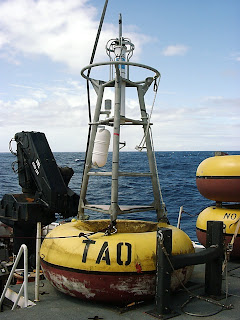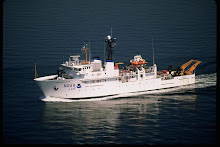
"Science isn't pretty..." Dexter from the cartoon Dexter's Laboratory tells his sister. What he really needs to say is that science is hard work, work that takes a team of scientists, technical specialists, and in this case the dedicated crew from the NOAA ship Ka'Imimoana. Yesterday was our first real taste of what it takes to get the data needed to understand the role of the tropical ocean in modifying the world's

climate. We began out day with a shallow cast of the CTD at 6N:155W that ended around 7AM. A shallow cast still goes to a depth of 1000 meters (how many feet is that?) and takes about two to three hours to complete. The Survey Technician, a couple of the deck crew and several officers worked though heavy winds (35knots) and seas of around 18 feet and intermittent downpours of rain to make the data from the TAO Buoy array more solid. Once the CTD was back on the ship and secured we headed toward our first recovery/deploy at 5N:155W.


 Once the buoy was completely recovered (about 4 hours) we set the deck for deployment of the new buoy and broke for dinner. After dinner we began the deployment which took about 3 hours and ended in the dark around 8PM. Deployment of buoys is basically the opposite of the recovery process: Nielspin, plastic coated steel cable, with its sensors attached are then attached to the buoy with its electronics.
Once the buoy was completely recovered (about 4 hours) we set the deck for deployment of the new buoy and broke for dinner. After dinner we began the deployment which took about 3 hours and ended in the dark around 8PM. Deployment of buoys is basically the opposite of the recovery process: Nielspin, plastic coated steel cable, with its sensors attached are then attached to the buoy with its electronics.  This line along with thousands of meters of braided line feed out into the water until the buoy’s anchor position is reached. Once the buoy was anchored in the water we waited for about a half an hour then swung by the buoy to check that it was operational. Once the buoy was confirmed as successful, the crew began to prepare for the 5N CTD and our first drifter buoy deployment.
This line along with thousands of meters of braided line feed out into the water until the buoy’s anchor position is reached. Once the buoy was anchored in the water we waited for about a half an hour then swung by the buoy to check that it was operational. Once the buoy was confirmed as successful, the crew began to prepare for the 5N CTD and our first drifter buoy deployment. 


No comments:
Post a Comment